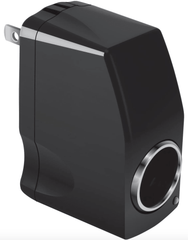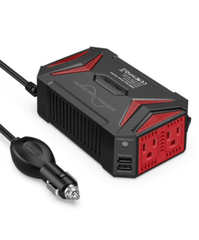Difference Between Current in Amps and Voltage in Volts
Be Mindful of Current in Amps and Voltage in Volts When Charging an Electrical Item.
Let us discuss how current (measured in amps) and voltage can affect the charging of an electrical item. It is common knowledge that a charger or power supply's voltage should be matched to the individual electrical product. For example, if a product says 10 volts DC, it is vitally important that exactly 10 volts DC are used to charge the product. If the product is charged at too high a voltage - for example, 15 volts DC - the product will almost certainly be destroyed. On the other hand, if too low a voltage is applied, the product simply won't work.
Let us take a simple example to understand how this works. When you purchase new batteries for your flashlight, your flashlight will shine brightly, just as it was intended. This is because the batteries are at the perfect voltage to match the needs of the flashlight. However, as you continue to use the product, the batteries will lose some of their charge. This causes the voltage in the batteries to drop, ultimately causing the light coming from the flashlight to dim. As the battery continues to lose charge, the flashlight will stop working altogether. The same principles extend to every electrical product, making it important that the correct voltage is applied when charging an electrical item.
Current is also supplied to an electrical item by a charger or power supply. More correctly, the electrical item consumes the current as supplied by the charger or power supply. The product will take exactly the amount of current that it needs to operate properly. This is where current differs from voltage. As we know, applying too high a voltage to an electrical item will cause the item to become destroyed. However, when it comes to current, it doesn't matter if too high a value is applied to an electrical item, as the item will only take the amount of current that it needs. For example, if an electrical item requires two amps of current, the charger should supply at least two amps of current. It does not matter if the charger is able to supply a higher amount - five amps, for example - as the product will only take the two amps that it needs. On the other hand, if the charger is only able to supply one amp of current, the product will either charge very slowly or will fail to charge at all. However, the product will not be damaged by supplying current that is either too high or too low.
For this reason, it is most important to ensure that the charger can provide exactly the right amount of voltage to suit each electrical item, but it is not a problem if the charger or power supply is able to provide a higher level of current than the item requires. As discussed above, each item will only draw the amount of current that it needs. If the current provided by the charger or power supply is too low, charging will either be slowed down or stopped altogether. Sometimes this can occur where a charger has been poorly designed, ultimately limiting the amount of current it can generate. It is typically only specific electronics labs that can test a charger to see if it has been poorly designed. What people can do, however, is pay careful attention to the list of product specifications supplied with an electrical item, or on the specifications imprint on the product itself.
For example, let us look at the electrical charging requirements for an iPad and see whether it is possible to use an iPhone charger to charge an iPad. Apple iPads require charging at 2.1 amps of current with 4.97 volts. When these specific requirements are not met, the iPad will become damaged (if a too high voltage is applied) or charging will take an unnecessarily long time (when a too low voltage is applied). The latter situation becomes apparent when an iPhone charger is used to charge an iPad. iPad chargers can supply the necessary 2.1 amps of current, however, iPhone chargers can only supply a maximum of one amp of current. Using an iPhone charger to charge an iPad will increase the amount of time taken to charge the iPad from empty to full capacity. This additional time requirement can be so extreme that, even if you place your iPad on charge in the afternoon and leave it charging all night, it may not be fully charged by the time you need it in the morning.
To find out the exact power supply requirements of your electrical item, you will need to locate two vital pieces of information: the current or amperage (measured in A or amps) and the voltage (measured in V or volts). In most instances, this information can be located in tiny writing on the electrical item itself, or you may find it printed somewhere on the original power supply. Otherwise, check the item's manual (either in hardcopy or by searching for a copy online), and look under the heading "Specifications". Alternatively, the manufacturer of the electrical item may have the information printed on their website.
Voltage.
Most of the power supply units we sell supplies voltage of 12-volts DC. Our chargers take the AC voltage that comes out of your wall's electrical socket (anywhere from 100 volts to 220 volts), apply the conversion, and generate an output of exactly 12-volts DC. This suits the vast majority of digital devices, including audio gear, hard drives, DVD players, and LCD screens.
Current (Amperage).
Once you are sure that you require, for example, a 12-volt DC power supply unit, the next step is to locate the amperage that your device requires. If you look in the specifications list or on the back of your electrical item, the original charger, or on the manufacturer's website, you will notice a number followed by an uppercase "A" next to the 12-volt DC. This represents the amperage or current required by your item.
As explained above, the amount of current quoted is a minimum, and you will need to choose a power supply that delivers at least that amount. For example, if you discover that your device requires two amps of current, a charger that supplies five amps of current will work just as well as a charger that supplies three amps of current or even two amps of current. However, you would not get effective results from using a charger that supplies less than two amps of current. For this reason, if you can't find a charger that supplies the exact amount of current that your device requires, always round up. For example, if your device requires 4.16 amps of current, look for a charger that supplies 4.5 amps or five amps.
Connectors.
Most of the power supply units that we sell include a standard, round barreled simple 12-volt DC connector. This is the same connector that is commonly used on the vast majority of 12-volt DC chargers and is center positive with an inner barrel of 2.5 millimeters and an outer barrel of 5.5 millimeters.
To confirm that your device uses the standard round barreled connector, simply have a look at the place on your electrical item where you would normally plug in your adapter, and visually note whether it is a circular barrel with a simple pin located inside. If so, you can feel confident that your item uses the standard, round barreled simple 12-volt DC connector. Other connector types will be very obvious on visual inspection, such as a four-pin connector or a double barrel connector.
Which 110V AC to DC 12V Converter to Buy?
We carry five AC 110V to 12V DC converters (see below). The first five are AC plug to DC socket converters. They offer max current transfer of 1 Amp, 2 Amps, 3 Amps, 8.5 Amps, 20.8 Amps respectively (or 1000 mA, 2000 mA, 3000 mA, 8500 mA, 20800 mA respectively). For example, it does not matter if it is 1Amp or 1000mA - they are both the same). As stated above, you must choose based on the number of Amps (A) or milliAmps (mA) that your electronic device can accept to charge itself or to make itself work. It will rarely be exact 1, 2, or 3 Ampere so it is best to round up to choose because greater Amp amount or number will not damage the device. The DC device will only absorb the max current in Amp it needs and ignore the rest. However, it is important to choose the converter with highest Amp possible so that the device works and/or gets charged as quickly as possible.










